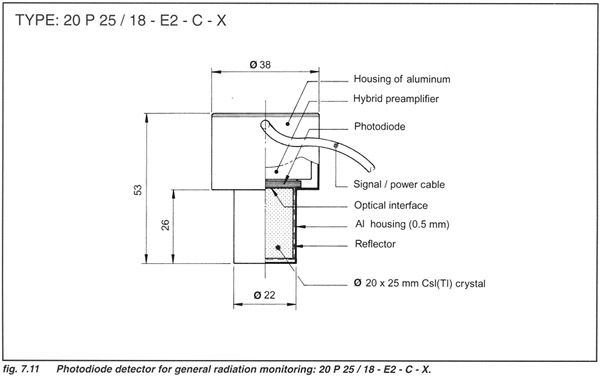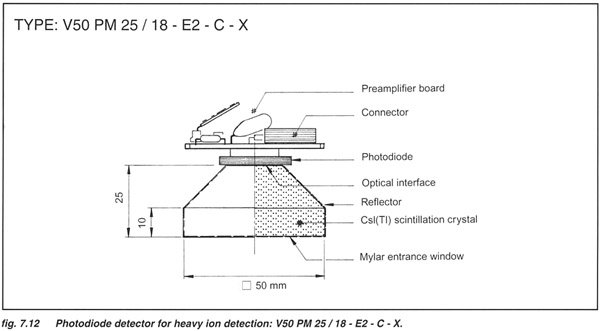 |
|
The advantages and limitations of photodiode detectors were discussed in section 4.2 . In general, photodiode scintillation detectors consist of a small PIN photodiode, integrally coupled to a scintillation crystal, often CsI(Tl). As a standard rule, a charge sensitive preamplifier is incorporated in the assembly. FEATURES The intrinsic noise of the photodiode/preamplifier combination prohibits the use of large scintillation crystals for detection of low energy (< 1 MeV) gamma-rays. This noise determines the lowest energy that can be detected with the device. CsI(Tl) crystals of 1 cm3 coupled to 10x10 mm2 PIN photodiodes can be used down to 40 keV; for larger crystals (e.g. for 2x2x2.5 cm3 coupled to 18x18 mm2 diodes), this energy is about 70 keV. APPLICATION Photodiode scintillation detectors
can be used e.g. in applications where: CsI(Tl) crystals do not crack or cleave and photodiodes are shock resistant. Many configurations are possible. The noise level and energy resolution of the detector depend very much on the crystal/diode configuration. Contact SCIONIX for your specific requirement. The noise of photodiode scintillation detectors increases with temperature. Above 50 o C these instruments are not advised. An important application of photodiode detectors is in physics research for the detection of charged particles. A thin silicon detector is placed in front of a CsI(Tl) crystal read out with a photodiode to perform an E / D E measurement. |
|||||||
 |
|||||||
 |
|||||||
SPECIAL To avoid the necessity for extra pulse shaping electronics, the SPD2000 was developed. This special photodiode detector includes a shaping amplifier with a maximal output of 10 V and line driving capabilities of 40 m. The output from the SPD2000 can be directly fed into an MCA or counter. For more information we refer to the special technical information leaflet of this instrument. For the detection of low energy X-rays, a bare photodiode without a scintillation crystal can be used in an assembly essentially the same as above but without the crystal. These assemblies are only useful below 50 keV since the standard thickness of PIN photodiodes is only 0.2 - 0.3 mm. |
|||||||
| BACK TO TOP | |||||||